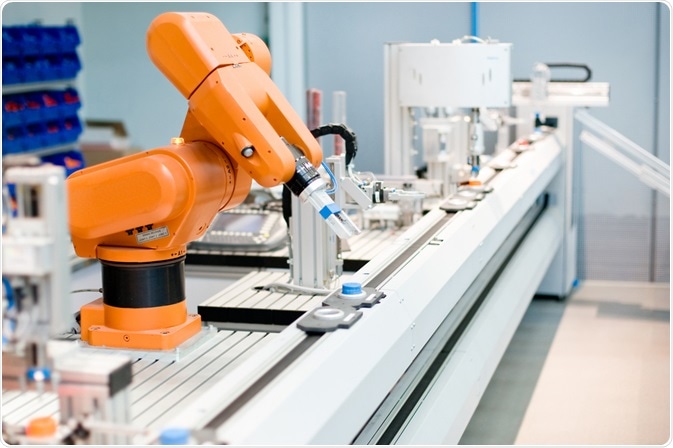While industrial and clinical laboratory settings have relied on automation for several decades to leverage the numerous benefits of minimizing human input and enhancing fine-grain control of all processes, the field of life sciences is yet to adopt automation to this level and still relies heavily on skilled staff to manually run tasks.

Lab Automation. Image Credit: SFC/Shutterstock.com
There is a need for life sciences to adopt automation in order to reduce the time and resources associated with manual processes as well as to enhance the quality, reproducibility, safety, and reliability of outcomes. However, before life sciences can make the most of automation, it must overcome some key challenges. We discuss these challenges below.
Skills gap
The advent of technical advances, such as those associated with laboratory automation, calls upon a new skillset from technicians. The challenge is that many laboratory technicians working in the life sciences sector are trained manually running tasks and are not familiar with the sophisticated software that is employed to oversee laboratory automation.
Machinery can be adopted to automate almost all parts of a scientific protocol, from organizing test orders, controlling specimen routes to inspecting the quality of test results, and diagnosing machine failures or deviations.
For laboratory automation in life sciences to be successful, staff must be thoroughly trained on how to use new software. Additionally, as the technology continues to develop, staff need to stay up to date with all advancements. Therefore, to overcome this challenge, regular training must be implemented as a duty of all laboratory staff.
Incorrect application
While automation is being widely adopted for the numerous benefits it brings, integrating automotive processes does not necessarily guarantee success. The incorrect application of automation within life sciences laboratories can result in decreased efficiency. Therefore, it is vital that those implementing automation technology must fully understand its capabilities and impact so that technology is only adopted where it presents a benefit.
Failure to correctly adopt automation can lead to a serious negative impact to test results. Due to their nature, errors made by automated machines have the capability of rapidly propagating those errors before they are detected. In addition, automation that is incorrectly applied can reduce the test reproducibility and weaken the consistency between results obtained at separate laboratories.
Further to this, inconsistency between results obtained from the same experimental protocol conducted at different sites can be caused due to variations in equipment set up, calibration errors, and use of different input materials. Machine-to-machine variability between laboratories is difficult to control for and remains a significant challenge to life sciences laboratories that choose to adopt automation technology.
Reduction of creativity and innovation
With the adoption of automation comes a lessening of creative thinking. Staff are no longer required to run tests manually, they are, therefore, less directly involved with the experimental design, and opportunities to adjust the protocol are less frequent. This can impact the creativity that occurs in the laboratory and, as a result, there may be a reduction in innovation.
Researchers have less opportunity to be immersed in the protocol and have inspiration as to how it can be optimized or adapted. In addition, staff working with automated equipment may assume that the machinery is optimized to the best of its capabilities, with no room for further innovation. Scientific advancements have always relied on innovation, therefore, the field of life sciences faces the challenge of maintaining high levels of creativity and innovation while adopting automation technology.
The expense of automation equipment is hard to justify
One of the greatest challenges to life sciences laboratories wanting to adopt automation systems is the significant upfront cost of obtaining new equipment. Commercially available equipment is expensive, and machinery that is tailored to specific purposes is even more so.
Cell culture experiments are common in life science research. The procedure is time-consuming and requires hours of lab technician’s focussed attention. Equipment to automate this process, however, still costs roughly $1 million to set-up, putting it out of reach of most academic institutions. While it has been available for two decades, the equipment remains significantly expensive, preventing the widespread adoption of automation equipment in life sciences and academic research.
Often, scientific funding to academic institutions is obtained through grants. These programs rarely fund new equipment and require researchers to innovate novel methodologies to obtain the answers to their research questions. This further reduces the adoption of automation within life sciences research.
Curbed development of automation equipment for life sciences
Finally, financial challenges that prevent life science laboratories from adopting automation equipment then, in turn, negatively impact the development of such equipment, particularly for its use in life sciences. Without demand and revenue from life sciences laboratories purchasing equipment, the commercial organizations who develop such equipment are limited as to how much they can invest in developing it further.
Overall, there is a lot to be gained from adopting laboratory automation in life science laboratories, such as enhanced quality, reproducibility, safety, and reliability. However, there are a number of key limitations that remain to be addressed for it can reach its full potential.
Sources:
- Genzen, J., Burnham, C., Felder, R., Hawker, C., Lippi, G. and Peck Palmer, O., 2018. Challenges and Opportunities in Implementing Total Laboratory Automation. Clinical Chemistry, 64(2), pp.259-264. www.researchgate.net/.../320180572_Challenges_and_Opportunities_in_Implementing_Total_Laboratory_Automation
- Holland, I. and Davies, J., 2020. Automation in the Life Science Research Laboratory. Frontiers in Bioengineering and Biotechnology, 8. https://www.ncbi.nlm.nih.gov/pmc/articles/PMC7691657/
- Laboratory automation in the life sciences: recent achievements and future challenges. Wendy Lauber. Innovations in pharmaceutical technology. Available at: https://www.iptonline.com/
Further Reading